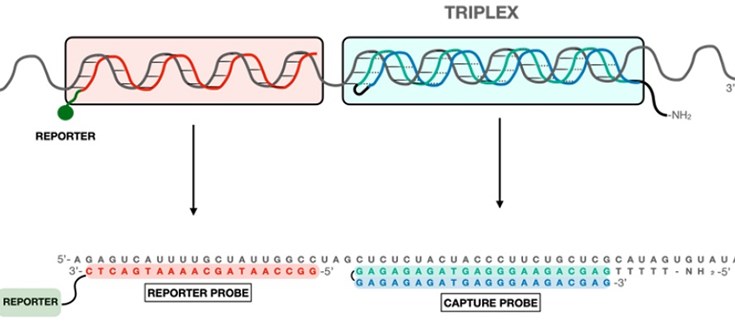New method for the detection of RNA viruses such as SARS-CoV-2
Several CIBER-BBN groups at the University of Barcelona, the Institute for Advanced Chemistry of Catalonia (IQAC-CSIC), the Institute of Microelectronics of Barcelona (IMB-CNM-CSIC) and the Institute of Nanoscience and Materials of Aragon (INMA) —a joint institute of the CSIC and the University of Zaragoza (UNIZAR)— have developed a new method for detecting RNA viruses based on the technology of using probes that form triplex structures. This innovative methodology opens up new options to detect viruses such as SARS-CoV-2, the influenza A (H1N1) virus or the respiratory syncytial virus (RSV), a pathogen that affects newborns and requires differential diagnostic care.
This interdisciplinary work, published in the International Journal of Molecular Sciences, is led by Carlos J. Ciudad and Verónica Noé, from the Faculty of Pharmacy and Food Sciences and the Institute of Nanoscience and Nanotechnology (IN2UB) of the University of Barcelona ; Ramón Eritja, Anna Aviñó, Lluïsa Vilaplana and M.Pilar Marco, from IQAC-CSIC and CIBER-BBN; Manuel Gutiérrez, Antoni Baldi and César Fernández, from the IMB-CNM-CSIC, and Valeria Grazu and Jesús Martínez, CSIC researchers at the Institute of Nanoscience and Materials and Aragon INMA (CSIC-UNIZAR) and CIBER-BBN.
The research has counted with the expertise of two NANBIOSIS Units from CIBER-BBN and IQAC-CSIC; NANBIOSIS U2 Customized Antibody Service (CAbS), led by Pilar Marco and Nuria Pascual, and U29 Oligonucleotide Synthesis Platform (OSP), led by Ramón Eritja and Anna Avinó.
This research work was carried out in the context of the PoC4CoV project, led by M. Pilar Marco and César Fernández and financed through the Interdisciplinary Thematic Platform of Global Health of the CSIC. Subsequently, the research has continued as part of a project financed by La Marató de TV3 in 2020 to fight against COVID-19 in which experts from the Faculty of Chemistry of the UB also participate.
Polypurine tweezers to capture viral RNA
The new methodology is based on the ability of polypurine tweezers (PPRHs) —designed by the UB cancer therapy group— to capture viral RNA and form a high affinity triplex. When this hybrid structure is connected to a molecular probe and is brought into contact with the affected patient’s sample, a viral agent detection signal is obtained. The method now presented in the scientific publication has been called the Triplex Enhanced Nucleic Acid Detection Assay (TENADA).
“PPRHs are unmodified single-stranded DNA hairpins that are made up of two mirror domains of antiparallel polypurines. These domains, connected to each other by a thymidine loop, are linked by intramolecular reverse Hoogsteen bonds. Molecular tweezers can specifically bind to polypyrimidine sequences in single-stranded (ssDNA), double-stranded (dsDNA) or RNA viruses through Watson-Crick bonds, thus forming an antiparallel triplex”, details Professor Carlos J. Ciudad, from the Department of Biochemistry and Physiology of the UB.
An effective and faster methodology than the PCR test
Among the advantages that it presents in the detection of viral RNA, it should be noted that the PPRHs methodology can be applied without the intervention of reverse transcriptase —the enzyme that converts RNA into DNA— or the thermocycler (the device that amplifies the material samples). DNA with polymerase chain reaction or PCR). In addition, it has a sensitivity and specificity equivalent to that of the PCR test and can provide results in less than an hour.
In the framework of the work, the team used the hybridization sandwich format in various biosensing devices. This approach uses two oligonucleotides: a triplex-forming PPRH hairpin to serve as the capture probe, and a labeled duplex-forming DNA oligonucleotide to serve as the detection probe.
“The triplex-forming PPRH hairpins were designed to bind to SARS-CoV-2 polypyrimidine sequences, while the detection probes were designed to complement a region near the polypyrimidine target site. Thus, the presence of SARS-CoV-2 RNA is detected by the formation of the ternary complex on the surface of the biosensor”, details Professor Verónica Noé (UB-IN2UB).
This methodology has been implemented in a compact electrochemical device that integrates an electrochemical cell with two electrodes on a chip —manufactured in the Micro and Nanofabrication White Room of the IMB-CNM-CSIC— and a paper fluidic component, and in a Lateral thermal flow implemented in nitrocellulose and using plasmonic nanoparticles and thermal paper that has been developed at the INMA (CSIC-UNIZAR).
TENADA: applications in biomedical research
PPRHs are described in the scientific literature as gene silencing tools for various genes mainly involved in cancer. In addition, they have also been incorporated as probes in biosensors for the detection of small RNA molecules (micro-RNA) to determine the state of DNA methylation and for the diagnosis of pneumonia caused by the fungus Pneumocystis jirovecii.
Now, the new TENADA methodology proves to be effective not only in the detection of viral particles. The high affinity of PPRHs for viral RNA is a property that can be applied to inhibit the virus replication process. For this reason, the antiviral properties of CC1PPRH and CC2PPRH polypurine clamps in cells of the VeroE6 lineage infected with SARS-CoV-2 virions are now also being studied.
In parallel, the work of the different groups involved has also been the basis of a technology that was patented and licensed in July 2022 through the participation of the UB Patent Center, the CSIC and the CIBER-BBN. In turn, this patent has been licensed non-exclusively to the Spanish company Nanoinmunotech through the management of the Bosch i Gimpera Foundation (FBG-UB) in the technology protection process and the company’s license agreement. .
Article of reference:
Aviñó, A.; Cuestas-Ayllón, C.; Gutiérrez-Capitán, M.; Vilaplana, L.; Grazu, V.; Noé, V.; Balada, E.; Baldi, A.; Félix, A.J.; Aubets, E.; Valiuska, S.; Domínguez, A.; Gargallo, R.; Eritja, R.; Marco, M.-P.; Fernández-Sánchez, C.; Martínez de la Fuente, J.; Ciudad, C.J. «Detection of SARS-CoV-2 Virus by Triplex Enhanced Nucleic Acid Detection Assay (TENADA)». International Journal of Molecular Sciences, diciembre de 2022. Doi:10.3390/ijms232315258









